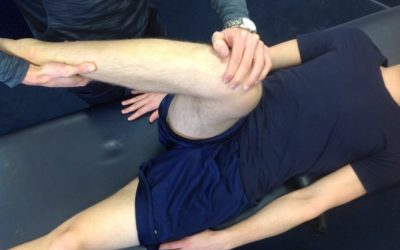Forward start and hip position
For field hockey players, the groin and hip region is more likely to become injured due to over usuage. During the various ice skating movements, a lot of force is deployed in the hip. This is also the case when a player makes a start on the ice. This technical aspect is frequently taught in young field hockey players to improve technique and explosion. When going forward, the hip is moved into two risky positions that would increase the likelihood of a brace (the attachment of different structures around the joint) at the hip.
Indeed, this is what is described by Justin D. Stull and his team, who analyzed the starts of peewee players. First, the first position is at risk during abduction and external rotation of the hip, or at the end of the push. Then, the second position may occur during the recovery phase while the hip joint is in flexion and internal rotation. It is also reported that the risk of injury associated with hip brace be partly related to the biomechanics of skating and potentially to the exposure of ice time, mainly at a young age (1).
An interesting result of the study is that not all the players who performed a hip adduction had a problem during the recovery phase (1). Such a difference can be explained by the variety of morphology between the players and the level of technical skills of each person. The flexion, adduction and internal rotation is described as being a risk for a brace (2) could have adverse effects if repeated many times. In short, the biomechanics of skating before a dead start can have a great influence on performance, but also on the probability of injury.
It is important to question current practices for sport. Completely eliminating this technical gesture is probably not the solution. By cons, considering the few times when the forward skating from a static position is used in game situations, we may question our methods and techniques of current teachings. To maximize the effectiveness of training and health of young field hockey players, coaches and physical trainers should avoid excessive amplitudes of ice movements specifically in technical gestures that are not used in game situation.
Written by Maxime Provencher, M. Physiotherapy
References:
1. Stull JD, Philippon MJ, LaPrade RF. At risk positioning and hip biomechanics of the pee wee ice hockey sprint start. Am J Sports Med. 2011 Jul;39 Suppl:29S-35S.
2. Rylander L & al. Femoroacetabular impingement and acetabular labral tears. Orthopedics. 2010 May. Vol,33. issue 5: 342-350.
You want to stay up to date and receive all the articles before anybody else?
Register to our newsletter.
From the same author
High ankle sprain in field hockey players: is it possible wearing skate?
High ankle sprain in field hockey players : is it possible wearing skate? Ève Physiotherapist Ankle sprains are not the first injury that comes to mind when you think about injuries in field hockey. The lateral ankle sprain, often seen in basketball and soccer is...
Field hockey and Yoga, a good combination?
Field hockey and Yoga, should we combine them? MAXIME Sport Physiotherapist The practice of yoga has been gaining popularity in North America since the beginning of the century. In 2005, there were more than 1.4 million people who practiced yoga in Canada alone. It...
What if the hip was guilty?
What if the hip was guilty? MAXIME Sport physiotherapist In previous articles, we discussed some risk factors for groin injuries and ways to prevent them. Beyond prevention, if there’s still pain in this region, it’s not always easy to return to play....


